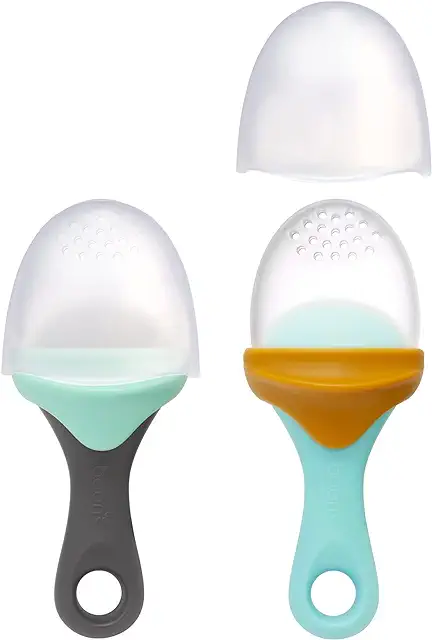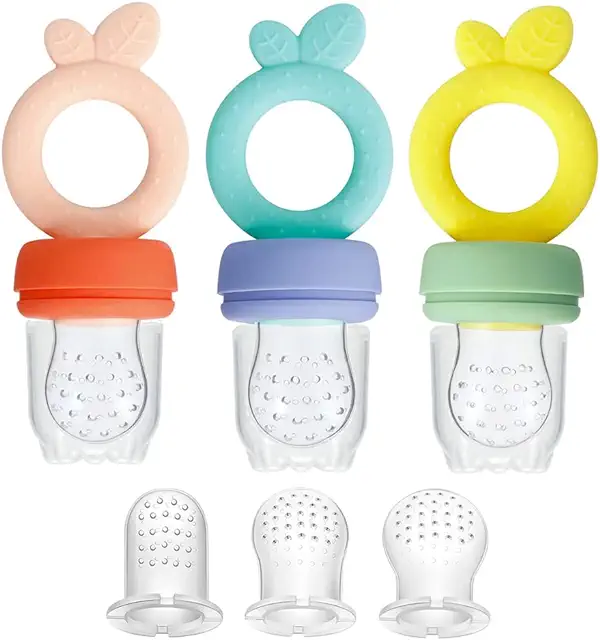Transitioning from liquid to solid foods is a major milestone in a baby’s growth, marking the beginning of exploring a wide range of tastes and textures. However, this transition can be challenging for both parents and babies, as it introduces the risk of choking and the struggle of teaching babies how to chew. Silicone baby food feeders offer a safe and effective solution to these challenges. Designed to hold solid food that babies can suck or chew on through small holes, these feeders minimize the risk of choking and make it easier for babies to learn how to eat solids. This article will guide you through choosing the right silicone baby food feeder, ensuring a smooth and enjoyable transition for your little one.

What Are Silicone Baby Food Feeders?
Silicone baby food feeders are innovative tools designed to facilitate the safe introduction of solid foods to babies. These feeders consist of a silicone pouch with small holes, attached to a ring or handle that babies can hold onto. Parents can fill the pouch with fresh, frozen, or cooked food, allowing babies to suck or chew on the contents at their own pace. This design significantly reduces the risk of choking, as only small, manageable pieces of food pass through the holes.
Design and Purpose
The primary purpose of silicone baby food feeders is to provide a safe, hygienic, and convenient way for babies to explore solid foods. They are especially useful during the teething phase, offering a soothing solution for sore gums when filled with cold fruits or vegetables. The feeders are designed to be easy for small hands to grip, promoting independence and fine motor skill development as babies learn to feed themselves.
Benefits for Babies and Parents
For babies, the use of silicone feeders encourages the development of chewing skills, taste exploration, and self-feeding. These feeders also reduce the frustration and mess commonly associated with the early stages of weaning. For parents, silicone feeders offer peace of mind by minimizing the risk of choking. They are also easy to clean, portable, and ideal for on-the-go snacks, making mealtime less stressful and more enjoyable.
Advantages of Silicone in Baby Food Feeders
Silicone is a remarkable material for baby food feeders due to its safety, durability, and hygienic properties. It’s a synthetic rubber that is BPA-free, non-toxic, and hypoallergenic, making it safe for babies to chew and suck on. Unlike plastics, which can contain harmful chemicals, silicone does not leach chemicals into food, even when exposed to heat or cold. This makes silicone feeders a healthier choice for feeding babies.
Safety and Hygiene
Silicone’s non-porous surface makes it resistant to bacterial growth, ensuring that feeders remain hygienic with proper cleaning. It is also highly heat-resistant, allowing it to be sterilized in boiling water, a dishwasher, or a microwave sterilizer without degrading. This ease of cleaning and sterilization further enhances its appeal to health-conscious parents.
Durability and Longevity
Compared to other materials like plastic or mesh, silicone stands out for its durability. It does not warp, fade, or deteriorate over time, which means silicone feeders can last through multiple children. This resilience also makes silicone feeders more resistant to bites and tears, ensuring that they remain safe for babies to use over extended periods.
Comparison to Other Materials
While plastic feeders may crack or harbor bacteria in scratches over time, and mesh feeders can be difficult to clean and quick to wear out, silicone feeders offer a superior alternative. They combine the best of safety, hygiene, and durability, without the drawbacks of other materials. This makes silicone baby food feeders a preferred choice for parents looking for a reliable, safe, and long-lasting solution to introduce solid foods to their babies.

How to Choose the Right Silicone Baby Food Feeder
Choosing the right silicone baby food feeder involves considering several factors to ensure it meets the needs of your baby’s developmental stage, promotes safety, and offers convenience for cleaning and maintenance. Here’s what you need to know:
Size and Shape
The size and shape of the feeder should match your baby’s age and oral development. For younger babies just starting on solids, smaller feeders with simple shapes are ideal. These feeders should fit comfortably in your baby’s mouth without posing a choking hazard. As babies grow and become more adept at chewing, larger feeders with varied textures can stimulate their oral development and introduce them to different food experiences.
Safety Features
Safety is paramount when selecting any baby product. Look for silicone baby food feeders that boast safety certifications and are made from 100% food-grade silicone. This ensures the feeder is free from harmful chemicals like BPA, lead, and phthalates. Additionally, high-quality silicone is resistant to microbial growth, making it a safer option for your baby.
Design and Functionality
Choose feeders with designs that cater to both the baby’s and the parents’ needs. Feeders with easy-to-hold handles allow babies to improve their grip and coordination while feeding themselves. For parents, feeders that are easy to disassemble ensure thorough cleaning, and those that are dishwasher-safe add an extra layer of convenience. Some feeders also come with interchangeable parts, allowing them to grow with your baby and adapt to their changing needs.
Safety Tips for Using Silicone Baby Food Feeders
Using silicone baby food feeders safely is crucial for preventing accidents and maintaining hygiene. Here are some essential tips to follow:
Cleaning and Sterilization
Keeping the feeder clean and sterilized is essential to prevent the buildup of bacteria and mold. Wash the feeder with warm, soapy water after every use, and consider using a bottle brush to reach all areas. For sterilization, options include boiling water, steam sterilizers, or dishwasher settings designed for baby products. Regularly check the feeder for any signs of damage or wear, as these can harbor bacteria.
Supervision
Always supervise your baby while they are using the feeder. Although silicone baby food feeders are designed to minimize choking risks, it’s crucial to watch your baby to ensure they are using it correctly and safely. This also provides an opportunity to interact with your baby and encourage their feeding exploration.
When to Replace
Inspect the silicone feeder regularly for signs of wear and tear, such as cracks, thinning, or tearing of the silicone. These signs indicate it’s time to replace the feeder to ensure your baby’s safety. Additionally, if the feeder has been used for an extended period, even without visible damage, consider replacing it as part of regular maintenance to ensure hygiene and safety.
Top Picks and Recommendations
When it comes to selecting the best silicone baby food feeders, the options can be overwhelming. To help you navigate, we’ve reviewed some of the top-rated feeders on the market, focusing on customer reviews, safety features, and price to give you a comprehensive guide.
Customer Reviews
Customer feedback is invaluable for understanding how a product performs in real-world scenarios. Products with high ratings and positive reviews are often the go-to choice for new parents. These reviews can provide insights into how easy the feeder is to clean, its durability, and if babies enjoy using it.
Safety Features
The best feeders are those that prioritize your baby’s safety. This means they’re made from 100% food-grade silicone, free from BPA, PVC, and phthalates. They should also have certifications from reputable organizations to back up these claims. Additional safety features might include a design that prevents choking and components that are easy to inspect for damage.
Price
While price is an important consideration, it shouldn’t be the sole deciding factor. Investing in a high-quality feeder that is safe and durable can save money in the long run, as it reduces the need for replacements. However, there are excellent options available at various price points to suit different budgets.
Based on these criteria, a few top picks include:
- Brand A’s Silicone Feeder: Known for its ergonomic design and ease of cleaning. It’s highly rated for its durability and comes at a mid-range price, offering great value for money.
- Brand B’s Easy-Clean Feeder: This option stands out for its innovative design that allows for thorough cleaning, minimizing bacterial growth. It’s slightly higher in price but justifies this with its advanced safety features.
- Brand C’s Budget-Friendly Feeder: Offers basic functionality with safety in mind, at a price point that is accessible for all. While it lacks some of the advanced features of pricier models, it does not compromise on safety or hygiene.
Conclusion
Choosing the right silicone baby food feeder is more than just a matter of convenience; it’s a critical decision that affects your child’s health and development. The right feeder will not only help in safely transitioning your baby to solid foods but also in developing their motor skills and independence.
Parents are encouraged to make informed decisions, prioritizing quality and safety over price. Remember, the goal is to provide your baby with the best possible start in their food journey. By selecting a feeder that meets high safety standards, is easy to clean, and is appropriate for your baby’s developmental stage, you’re investing in their well-being and enjoyment of new tastes and textures.
In the end, the best feeder is one that suits your baby’s needs and your lifestyle, offering peace of mind with every use. Let your baby’s smiles and eagerness to explore new foods guide you to the perfect choice.
FAQ: Silicone Baby Food Feeders
What is a silicone baby food feeder?
A silicone baby food feeder is a baby feeding accessory designed to allow infants to safely taste and explore solid foods. It typically consists of a silicone pouch with small holes through which the food can be mashed and sucked by the baby, reducing the risk of choking.
Why should I choose a silicone feeder over other materials?
Silicone is preferred for baby food feeders because it’s safe, non-toxic, BPA-free, hypoallergenic, and easy to clean. Unlike plastic or mesh materials, silicone doesn’t harbor bacteria easily and is more durable against bites and tears.
How do I clean a silicone baby food feeder?
To clean a silicone baby food feeder, disassemble it and wash each part with warm soapy water. You can also place it in the dishwasher if it’s labeled dishwasher-safe. For thorough sterilization, boiling in water for 3-5 minutes or using a steam sterilizer is recommended.
At what age can my baby start using a silicone food feeder?
Babies can start using a silicone food feeder as soon as they show interest in solid foods, typically around 6 months of age. However, it’s important to consult with a pediatrician to ensure your baby is ready for solids and to discuss any potential food allergies.
How often should I replace the silicone feeder?
It’s advisable to inspect the silicone feeder regularly for signs of wear and tear, such as cracks, thinning, or tears. Generally, replacing the feeder every 3-6 months or immediately upon noticing any damage ensures that your baby continues to use a safe and hygienic product.